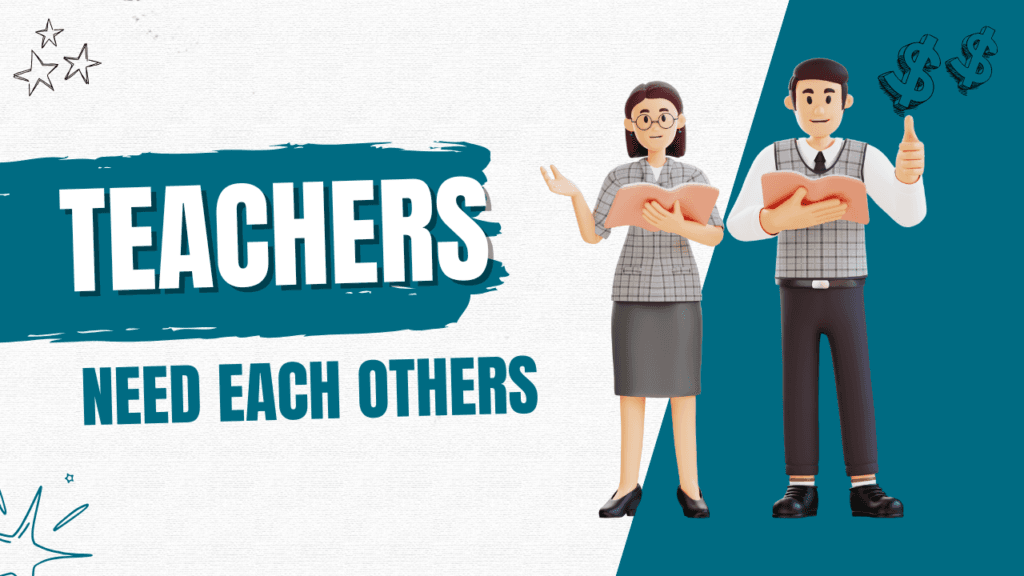Teaching is more than just a profession; it’s a vocation that calls for unwavering dedication, resilience, and adaptability. In today’s educational climate, teachers face unprecedented challenges ranging from integrating technology into the classroom to addressing diverse learning needs. Amid these hurdles, collaboration and mutual support among educators have become essential for achieving both professional growth and student success.
The Importance of Teacher Collaboration:

Collaboration among teachers is not merely about working together—it’s about fostering a culture of shared learning and collective problem-solving. Here’s why collaboration is crucial in today’s education system:
1. Sharing Resources and Strategies
Pooling Knowledge and Expertise: Collaboration enables teachers to pool their knowledge, experiences, and resources. For example, an experienced math teacher might share a unique approach to explaining algebra, while another might provide tips on integrating multimedia into lesson plans. By leveraging each other’s strengths, educators can offer more comprehensive and engaging learning experiences to students.
Adapting to Diverse Learning Needs: Every student learns differently, and collaborating with peers can help teachers uncover new strategies to cater to these varied needs. For instance, co-planning lessons for special education students or brainstorming ways to challenge gifted learners becomes easier when educators work together.
2. Professional Development Opportunities
Continuous Learning and Growth
Teaching is a dynamic profession that demands continuous professional development. Collaborative environments, such as teacher networks or professional learning communities, provide ample opportunities for growth. Educators can share insights from workshops, exchange resources for classroom management, or discuss the latest teaching tools.
Keeping Pace with Innovation
With the rapid evolution of educational technologies, staying updated is vital. Collaborating with tech-savvy colleagues helps teachers integrate tools like AI-based learning apps or interactive whiteboards into their classrooms effectively.
Building a Supportive Community:

Collaboration among teachers goes beyond academic or professional exchange. It creates a sense of community, which is essential for navigating the emotional and mental challenges of teaching.
Emotional and Moral Support
Navigating Challenges Together
Teaching is not without its stresses burnout, workload pressures, and dealing with students’ behavioral challenges can take a toll on even the most passionate educators. A supportive network of colleagues can offer a shoulder to lean on. Sharing stories, venting frustrations, and exchanging encouragement can alleviate stress and foster resilience.- Fostering Well-Being
A collaborative environment can also help promote teachers’ mental well-being. For example, some schools have started teacher wellness programs or regular meetups where educators share self-care tips and practices.
Advocating for Change
Collective Advocacy
Teachers are often on the frontlines of education reform, but individual voices may go unheard. When educators band together, their collective voice becomes a powerful tool for advocacy. Whether it’s pushing for better funding, improved classroom resources, or fair policies, a united teaching community can influence change more effectively.
Examples of Impact
Consider the recent movements in some states where teachers came together to advocate for better salaries and classroom conditions. These collective efforts highlight the strength and effectiveness of teacher collaboration.
Strengthening Student Outcomes:

Ultimately, the primary goal of teaching is to maximize student learning. Collaboration among teachers plays a significant role in achieving this objective.
Improving Student Engagement and Achievement
Enhancing Learning Environments
Teachers who collaborate can create dynamic, interactive learning environments. For instance, a team of teachers working on an interdisciplinary project combining history, art, and science can create a richer learning experience for students.- Inspiring Innovative Practices
Innovative teaching practices often emerge from collaboration. Educators who share successes in engaging students, such as using gamification in lessons or incorporating project-based learning, can inspire others to adopt these methods.
Encouraging Peer Mentorship
Learning From One Another
Mentorship is another benefit of collaboration. New teachers often face a steep learning curve, but guidance from experienced colleagues can ease this transition. Peer mentoring programs within schools can build confidence and competence in educators.Developing Leadership Skills
Collaboration also provides opportunities for teachers to step into leadership roles, such as leading professional development sessions or mentoring peers. These experiences not only benefit the mentee but also enrich the mentor’s professional journey.
Overcoming Barriers to Collaboration
Despite its many benefits, collaboration among teachers can face barriers such as time constraints, lack of administrative support, or differing teaching philosophies. However, schools can foster collaboration by:
- Scheduling regular professional learning community (PLC) meetings.
- Providing digital tools like collaborative platforms (e.g., Google Workspace, Microsoft Teams).
- Encouraging team teaching and interdisciplinary projects.
Schools that invest in building a collaborative culture will reap benefits not just for teachers but also for students and the entire educational system.
Conclusion:
Rapidly evolving educational landscape, the importance of teacher collaboration cannot be overstated. By sharing resources, supporting one another emotionally, advocating for change, and improving teaching practices, educators can create positive, long-lasting impacts on student learning outcomes. Collaboration not only strengthens the teaching profession but also ensures a brighter, more promising future for students.
As teachers navigate complex challenges, their collective efforts demonstrate that they are indeed stronger together. Collaboration, community, and mutual support are the cornerstones of effective teaching in the modern age. Now more than ever, teachers need each other to thrive and inspire the next generation.


